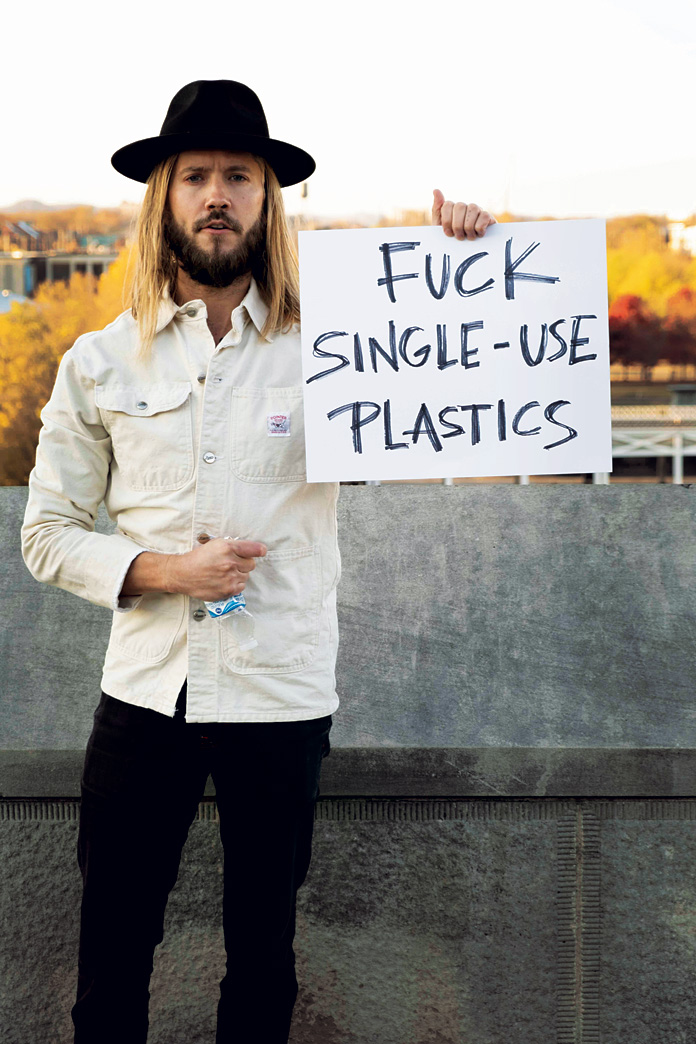
Trevor Terndrup of Moon Taxi (photo by Crackerfarm)
How to Be a Proactively Environmentally Conscious Artist
Putting Words Into Action
Oct 28, 2021
Issue #68 - Japanese Breakfast and HAIM (The Protest Issue)
![]()
Recycling, composting, and avoiding single-use plastics are daily activities that many individuals in the Western world practice. Some go a step further with drought-tolerant gardens, urban farms, becoming vegan, cruelty-free products, and curtailing fast fashion. Musical artists like to think fighting climate change, going green, environmental consciousness, and eco-friendliness are part of their existence as a default. Many donate to environmental causes—making sure to signal their actions when they do. Others occasionally perform at environmental-focused benefits and fundraisers—suddenly and temporarily becoming very vocal on the issue on their social media channels. But how much of what musicians actually do as artists have environmental awareness and eco-proactivity built into it?
Other than in-person appearances, limited quantity physical products and merchandise—which have their own horrific carbon footprint—a musician’s presence and product exist mainly online. This virtual space, be it websites, social media platforms, streaming services, or email lists, feels weightless and ethereal. The “cloud” implies fluffiness and vapor, nothing tangible. Yet all of these carry a hefty digital footprint.
The environmental organization Climate Care has an infographic on its site that shows how Internet-based activities such as emails, searches, streaming of music and video, and cloud storage lead to the stark fact that, “If the Internet were a country, it would be the world’s seventh largest polluter,” according to the website for Erjjio Studios, a UK-based boutique green web hosting and design company. “Digital technology accounts for around 4% of global carbon emissions.”
“When you use digital services, it’s not just the device in front of you that’s using energy,” says Ben Clifford, founder and managing director of Erjjio. “There is a big, physical warehouse-style building somewhere else in the world housing thousands of servers, permanently switched on so that everything is always immediately available on-demand. The energy used by the communications network between the city you’re in and that building, that’s what you don’t see. When you connect to the Internet, it feels like it’s the phone in your hands that’s using energy, but there are huge buildings behind the scenes that are doing all the work.”
There are small but effective ways to reduce the amount of energy used in online activities. Some of these include unsubscribing from email newsletters that aren’t read, not hitting “reply all” unless necessary, powering down or putting devices to sleep, unplugging from the power outlet, and using handheld devices for quick searches.
It doesn’t take much know-how to create a website, particularly with simple and affordable builders such as Wordpress and Squarespace. It also doesn’t take much to test your website to see just how “green” it is, meaning, how much renewable energy its hosting data center uses and how efficient and optimized the site is in minimizing carbon emissions when transmitting data. Tech giants such as Apple, Google, Facebook, and Instagram have already switched to green hosts. Doing the same on a micro-level is an infinitely more stress-free process.
Erjjio (and numerous other green hosting sites) provide not only a quick check that can determine the eco-friendliness of any website, but also a smooth and speedy transition to their green web hosting platform that maintains the look, the usability, the interaction, the statistics, and the speed (which it sometimes improves) at likely a lower price point.
“Most people don’t realize they have a choice,” says Clifford of opting for an eco-friendly web hosting platform. “At the individual level, these changes are quite small. But when you think about a site that has 100,000 visitors or so a month who are pulling that data to their device, when you add that up, it’s a significant change. If you apply that same principle to all websites, you end up having quite a big impact.”
_05_Face.jpg)
This carries over to streaming music. As convenient as listening to music on streaming services is, every time a song is played, yes, the artists get paid (a negligible amount), but Guy Lawrence of the British dance duo Disclosure encourages fans to download the song onto their phones and play it that way instead. Disclosure have taken multiple eco-friendly measures surrounding the release of their latest album, ENERGY. Not the least of these is using recycled plastic for the vinyl and cassette formats, 100% recycled plant-fiber board for the CD and vinyl sleeves, and shrink-wrapping with sustainable sugarcane-based plastic. The resulting products are comparable in audio quality to traditionally used supplies and are collectors’ items, as each piece has its own unique look due to the recycled nature of the materials.
“Distributing physical products is never carbon-neutral, it’s just not possible,” says Lawrence who powers his home studio wholly by solar panels. “We didn’t want to not do any physical products at all, but we wanted to do them not using any first-time plastics and using sustainable materials.”
Disclosure used the France-based company MPO for their eco-product needs. MPO is one of the leaders in this space, as is the Netherlands-based company, Deepgrooves. The latter operates at almost 100% sustainability in the way the pressing plant is run, in the materials they use, and in shipping.
“It started with a different angle on what an ideal production environment would look like with an almost 100% sustainable and circular environment with maximum result, minimum waste, and a superb musical product,” says Deepgrooves’ founder Chris Roorda. “The machines we use to press run on green energy, green gas, and solar energy powered by local suppliers. We use granulate with environmentally friendly stabilizers, FSC products, labels, vegan ink, biodegradable ‘plastics,’ and carbon neutral shipping. We try to avoid shrink wrapping as much as possible.”
While some musicians are making the impractical move of only buying used clothing to offset wasteful fast fashion, others, such as British metalcore band Architects, are producing limited edition merchandise that is responsibly sourced and packaged (via their Architects Merch Co.). South California-based indie rock trio Sir Sly have taken production of their merchandise in-house with their management forming the Still Merch company.
“We started Still Merch as a way to reduce inventory, upfront coasts, offer a more sustainable and eco-friendly alternative to standard screen printing and a more customized product,” says Fernando Costa of Reynolds Management, who handle Sir Sly. “We use water-based inks. We only print on demand so we’re mindful of garments being used versus wasted. Our shop has been inspected and it does not produce any sort of toxic waste or vapors. The water-based ink quality is such that you can barely feel it on black garments and you cannot feel it at all on light garments. It’s a win/win for everyone with higher quality, less cost, and more love for the planet.”
Nashville-based indie-alternative band Moon Taxi utilizes the eco-friendly Alternative Apparel for their merchandise. Alternative Apparel use eco-fabrics such as organic cotton, recycled cotton, modal interlock (raw material wood and cotton), and hemp-blend, all moving toward the company’s promise that “we pledge to replace all virgin polyester with 100% recycled polyester in future fabrics.”
Moon Taxi also works with the non-profit, Reverb, who “inspire millions of music lovers and music makers to take part in tackling today’s most pressing environmental and social issues.” Reverb partners with musicians from The 1975 to Fleetwood Mac, festivals, and venues to operate as green as possible, at the same time engaging fans “to take environmental and social action.” Reverb’s flagship #RockNRefill program provides free water filling stations and reusable bottles at concerts and festivals. The data on the organization’s site states it has eliminated the use of three million single-use plastic bottles since 2013.
“I’m a renegade recycler. I find anything that can be recycled and bring it back home to put in the bin,” says Moon Taxi frontman Trevor Terndrup, who volunteers at the Tennessee River Keeper Organization in his home state. “Now is the time to do something for your future, children’s future, and their children’s future. We’ve tried to use our music to make sure these environmental issues are heard.”
Making touring wholly green is a not exactly possible. The next best thing is to make it carbon neutral by offsetting your touring carbon footprint. One of the plans Disclosure have in place is partnering with the Dutch company Just Diggit, who not only focus on re-greening, but also on re-wilding and increasing biodiversity, paying as much attention to the carbon aspect as to the extinction aspect. Just Diggit also provides jobs to local women and educates them on farming, grazing animals sustainably, and how to not interfere with natural wildlife patterns.
“We need to do better than be sustainable,” says Disclosure’s Howard Lawrence, who has reforested the land around his home. “We need to be regenerative. Everyone always talks about having a smaller footprint. I say, ‘I want to have a bigger footprint, but I want it to be a good footprint.’”
Erjjio has a similar approach taking their green hosting a step further with their partnership with the Eden Reforestation Project, whose concentration is on planting native tree species in regions that have suffered from deforestation and creating local jobs in the process. Erjjio plants trees based on the services their clients purchase, with at least one tree planted per month per client for hosting services. The more services they provide, the more trees get planted, the cost of which Erjjio takes on, at no extra charge to their clients.
Eden Reforestation Project is also who the search engine Ecosia uses. Switching to Ecosia for Internet searches—which anyone can do in about five seconds—results in one tree being planted for every 45 searches, on average. Ecosia keeps track of your searches and has a counter for how many trees have been planted on your behalf, as well as how many trees have been planted on behalf of their aggregate user searches.
Few musical artists would say they don’t want to make more eco-conscious physical and virtual products as well as be more environmentally proactive. But these ventures take time and money, and they don’t make money.
“A certain level of artist, who has success, and is at a certain point in their career, with some money in the bank, it’s time to dedicate some of what would have been profit back,” says Guy Lawrence. “For the first five, six, seven years of our career, we didn’t think about this stuff. We thought about making a name for ourselves, strike while the iron’s hot. Ten years in, it’s about weighing up what’s important. Do we just want to maximize profit while we’re doing this job? Or do we want to try and set an example for those around us, and those that come after us? It’s time to leave a different kind of mark on the world.”
[Note: This article originally appeared in Issue 68 of Under the Radar’s print magazine, which is out now. This is its debut online. The issue was our 2021 Protest Issue, in which we once again examined the intersection of music and politics and conducted photo shoots with musicians holding protest signs of their own making. We are posting the article today in honor of Sustainability Day.]
Support Under the Radar on Patreon.
Most Recent
- Premiere: Mia Day Shares New Single “Mountain Song” (News) — Mia Day
- Tallinn Music Week, Tallinn, Estonia, April 3-7, 2024 (Review) — Virta, Musta Huone, Mari Kalkun, Sven Grünberg
- Picnic at Hanging Rock [4K UHD] (Review) —
- Joe Goddard of Hot Chip Announces New Album, Shares Video for New Song “Moments Die” (Feat. Barrie) (News) — Joe Goddard, Hot Chip
- Premiere: O Slow Shares New EP ‘Every Time I Look In The Mirror’ (News) — O Slow


Comments
Submit your comment
There are no comments for this entry yet.